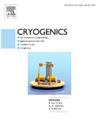Evaluation of a fixed-interface multi-region model for long-term evaporation in cryogenic propellant tanks
IF 2.1
3区 工程技术
Q3 PHYSICS, APPLIED
引用次数: 0
Abstract
Recent booming applications of cryogenic fluids in aerospace engineering, liquefied natural gas industry, and hydrogen energy have accentuated the demands for long-term cryogenic storage. A more comprehensive understanding of cryogenic evaporation in storage tanks has become a priority for reducing boil-off loss, extending storage duration, and guaranteeing container safety. Efficient modeling of interfacial heat transport has become the bottleneck for high-precision prediction of the steady-state evaporation of cryogenic fluids. This study addresses this challenge by developing a fixed-interface multi-region model, to simulate the steady-state evaporation characteristics in cryogenic storage tanks. The fluid domain is modeled as two regions for liquid and vapor phases and a fixed interface. The model is validated to accurately predict the temperature jump at the liquid–vapor interface. An analysis of the interfacial energy transport patterns is also provided. Furthermore, the performance of the fixed-interface model was compared with a VOF model in terms of simulation speed, interfacial temperature, and interface geometry. The results showed that the fixed multi-region model accurately predicted the interfacial temperature distributions, particularly in the vicinity of the liquid–vapor interface compared to the VOF model, while demanding only 3.6 % of the computational resources.
低温推进剂储罐长期蒸发的固定界面多区域模型评价
近年来,低温流体在航空航天工程、液化天然气工业和氢能等领域的应用日益蓬勃,对长期低温储存的需求日益突出。更全面地了解储罐中的低温蒸发已成为减少蒸发损失,延长储存时间和保证容器安全的优先事项。界面热传递的高效建模已成为低温流体稳态蒸发高精度预测的瓶颈。本研究通过开发一个固定界面多区域模型来模拟低温储罐的稳态蒸发特性,从而解决了这一挑战。流体域被建模为液相和气相两个区域和一个固定的界面。经验证,该模型能准确预测液汽界面处的温度跳变。对界面能量输运模式进行了分析。此外,从仿真速度、界面温度和界面几何形状等方面比较了固定界面模型与VOF模型的性能。结果表明,与VOF模型相比,固定多区域模型准确地预测了界面温度分布,特别是液-气界面附近的温度分布,而所需的计算资源仅为3.6%。
本文章由计算机程序翻译,如有差异,请以英文原文为准。
求助全文
约1分钟内获得全文
求助全文
来源期刊

Cryogenics
物理-热力学
CiteScore
3.80
自引率
9.50%
发文量
0
审稿时长
2.1 months
期刊介绍:
Cryogenics is the world''s leading journal focusing on all aspects of cryoengineering and cryogenics. Papers published in Cryogenics cover a wide variety of subjects in low temperature engineering and research. Among the areas covered are:
- Applications of superconductivity: magnets, electronics, devices
- Superconductors and their properties
- Properties of materials: metals, alloys, composites, polymers, insulations
- New applications of cryogenic technology to processes, devices, machinery
- Refrigeration and liquefaction technology
- Thermodynamics
- Fluid properties and fluid mechanics
- Heat transfer
- Thermometry and measurement science
- Cryogenics in medicine
- Cryoelectronics
 求助内容:
求助内容: 应助结果提醒方式:
应助结果提醒方式:


